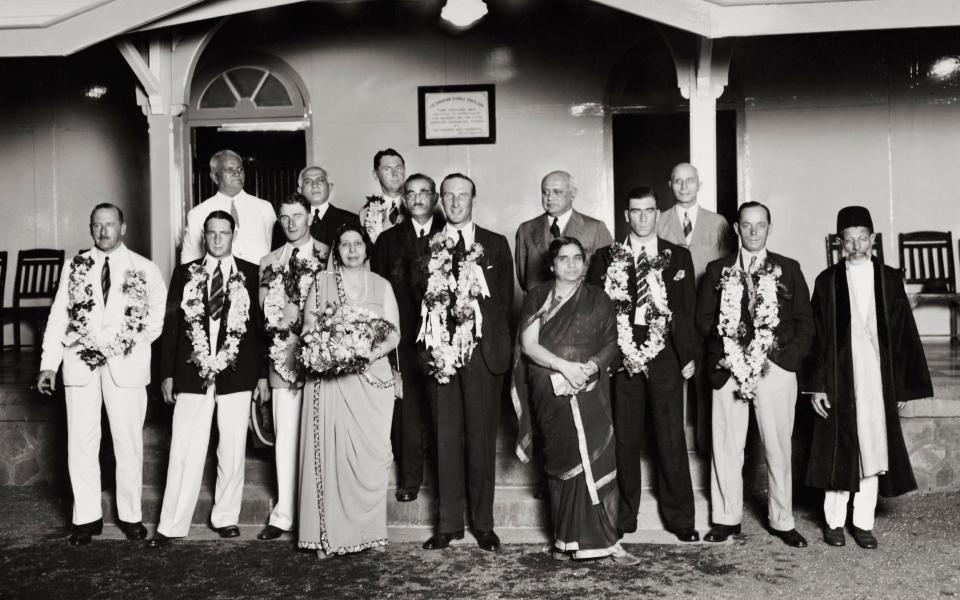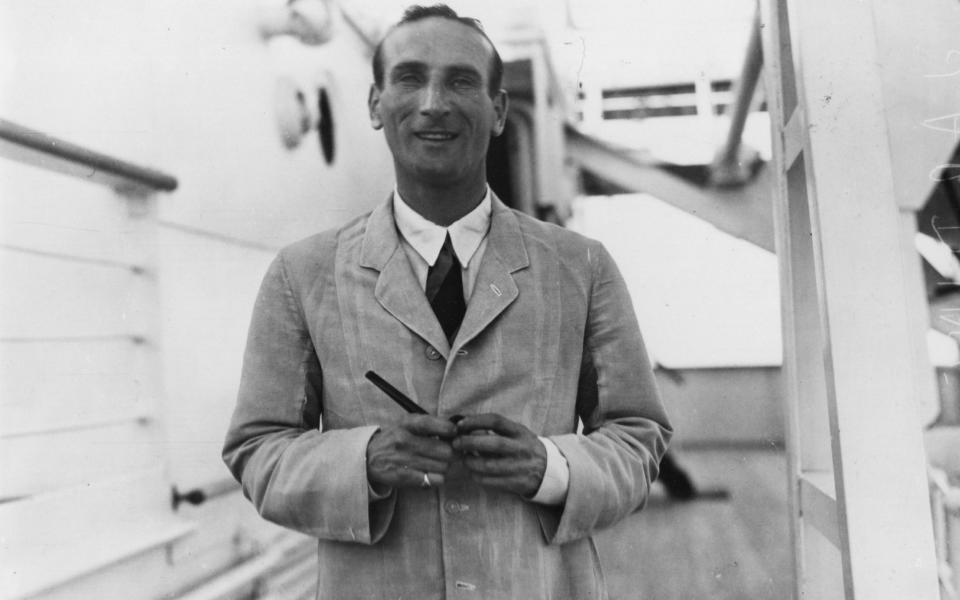The ground staff at the Bombay Gymkhana are re-marking the five-a-side football pitches with whitewash and the chalet-style café in the Swiss Pavilion is doing well.
The wicker chairs on the veranda overlooking the field are all occupied and the ceiling fans hum loudly to keep everyone cool as waiters in vests take orders and pour drinks.
It is a scene that has changed little since 1933, when the club hosted India’s first Test match, the 90th anniversary of which occurred about six weeks ago. Then it was a club for the British. The clubhouse rules had to be relaxed to allow the Indian players to enter the pavilion.
Now it remains an exclusive venue for the wealthy, a contrast to the skinny Azad Maidan which is separated from the Gymkhana by a narrow path that Mumbaikers use to cut through to the city. As you descend the stairs from the veranda you pass a black and white photograph taken on December 15, 1933, the first day of the Test, of two men staring at the camera. One is Douglas Jardine, the other CK Nayadu – the two captains representing dashing figures of the time.
Jardine, with his hands behind his back, wears a white tie with the George and Dragon emblem on his blazer, which is closed with three buttons. Nayudu looks like a movie star with his neat mustache and pomaded hair. He is slightly less formal, posing with his hand in his pocket and his blazer unbuttoned. Another photo shows him getting to work with Lala Armanath, followed by an official wearing a pith helmet. The young Armanath would make a name for himself and make a small fortune with a century in the match.
A short walk away, across the Cross Maidan, is the Cricket Club of India, the Brabourne Stadium, founded by the Maharaja of Patiala in response to being told that he could not sit in the pavilion of the Gymkhana. It hosted Test cricket until the early 1970s, when a dispute led the BCCI to build the Wankhede Stadium, the modern home of IPL and international cricket.


Less than a mile apart, but separated by almost a century of progress and change, the three grounds tell the story of the evolution of cricket in India.
The Gymkhana is a listed building, so Jardine would recognize it from its time, along with the Bombay High Court opposite, where his father, Malcolm, practiced law in the early 20th century.
Jardine’s tour to India was a year after Bodyline. He had to be persuaded to captain England again and part of his motivation was to see where he was born and the old family home. Malabar Hill, where the Jardines lived, is now home to modern skyscrapers, a haunt for Mumbai’s super-rich. Many of the colonial buildings are long gone, the skyline has changed dramatically.
Jardine made many speeches during the tour and predicted that India would one day become cricket’s greatest power. That’s something Ben Stokes would recognize now.
If you read through the press releases from the competition, some of the comments seem very familiar today. Jardine was a tactical master, completely devoted to his team and their methods. He was of course not without vanity, and the tour would include some tense moments of England bowling bumpers, but he was praised for his substitutes, the rotation of his bowlers and for being a diplomat – not a natural strength of his – who gave speeches. he recognized the importance of Anglo-Indian ties, although his relationship with Governor-General Lord Willingdon cooled when they rowed over the time for a cricket pitch to be rolled.
Stokes doesn’t need to bother with that kind of diplomacy. He would also pale about the schedule: 50 games in five and a half months with a fourteen-man squad. This tour consists of five tests in seven weeks, with a chef, analyst and massage therapist looking after the players.
While Jardine relaxed by hunting big game (he had a lion, tiger, panther, bear and deer, among others), Stokes prefers to take potshots on the golf course. The current England squad speaks with awe and praise of Stokes’ managerial skills. In his excellent biography of Jardine, the Spartan cricketer, Christopher Douglas quotes letters he received from some of the players during the 1933 tour. Kent wicketkeeper Hopper Levett said that Jardine did not “exude much cheerfulness and seemed to adopt an aggressive attitude towards the opposition”. By contrast, Middlesex batsman John Human described a “great man and a credit to Winchester College” who wrote to his parents when Human came down with malaria in Bombay. Human felt that his aloofness was due to an “inferiority complex towards strangers.”


The players lined up to praise his tactics, even with a seriously weakened team. The tour featured four bowlers: Nobby Clark from Northants and Stan Nichols from Essex, while India had Mohammad Nissar and Amar Singh. There were more bruises than the body line, although the leg theory was rarely applied – When it did, England were barracked in the first Test, and again in Madras when India opener Naoomal Jeoomal missed a hook and was bowled out.
England won the first Test by nine wickets (and would go on to win the series 3–0). The wire report states that most of the opening over England consisted of “bumpers” and that Jardine dropped a “sitter” of a catch. “The ground took on an animated appearance as members of all castes crowded in and struggled for vantage points. Makeshift shelters from the sun, consisting of canvas sheets spread on poles, were filled to the brim, and as a backdrop were minarets of mosques, some of the finest examples of Indian architecture,” said a report on the front page of the Birmingham Daily Gazette .
Former England captain Arthur Gilligan gave his assessment in the Daily News based on reading teletexts and an on-the-spot report from Jack Hobbs, who worked for the Daily Star. “The outstanding feature was the magnificent captaincy of DR Jardine who, as I suggested he would, excelled in fielding and bowling changes. Examination of the cables shows that Jardine was making plans and plans all along.
“The dismissal of Naidu (sic) was the result of an astute piece of captaincy from Jardine. The skipper moved a man from the leg side, creating a gap in the field, and Naudi, trying to place the ball in that direction, missed it fatally (and was lbw).


A similar judgment has been written about Stokes many times, including on this tour. It was Lala Armanath (written in the British press as Amar Nath) who became a hero for his 118, and on day three a crowd of 50,000 was drawn to the Gymkhana to see him make his century. He was presented with a wreath of flowers at the end of the match as India cricket’s obsession with personal milestones began. The front page of the British Daily Herald: “Hindu women took off diamond nose rings and earrings and took off bracelets and anklets to give gifts for Amar Nath. Checks, cash, jewelry, trophies, medals and batons were deposited on him. Several Hindu millionaires present insisted that the cricketer accept checks from them. A car was the gift of another millionaire. He had to employ several coolies to bring all his presents to the hotel. Tonight Amar Nath is the most famous man in India. A week ago he was unknown outside local cricket circles.’
Cricket had the power to change lives then, and it does so now. Just ask Yahasvi Jaiswal, who started his cricketing journey at the Azad Maidan, a short drive from the Gymkhana.
One last word about Jardine. On his day off in Bombay, he met his old house servant and took him to the grave of his late wife. Moments later he fell dead. Jardine took him to the hospital in vain. It was a very different touring life back then.